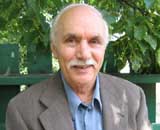Jump to navigation
03 September 2011
The single-process biochemical reaction of Rubisco: a unified theory and model with the effects of irradiance, CO₂ and rate-limiting step on the kinetics
Biosystems
Volume 103, Issue 2, February 2011, Pages 265-284
Computational Models of Photosynthesis.
Hadi Farazdaghi
"http://www.sciencedirect.com/science/article/pii/S0303264710002066">Click here to download.
Attention please:
In SCienceDirect issue, the powers of variables from equation 5 to equation 9 are mistakenly given to the coefficients of the variables. Before the correction is made, please either consult the hard copy or get a free copy from the author at hadi@farazdaghi.com.
Abstract
Photosynthesis is the origin of oxygenic life on the planet, and its models are the core of all models of plant biology, agriculture, environmental quality and global climate change. A theory is presented here, based on single process biochemical reactions of Rubisco, recognizing that: In the light, Rubisco activase helps separate Rubisco from the stored ribulose-1,5-bisphosphate (RuBP), activates Rubisco with carbamylation and addition of Mg≤(+), and then produces two products, in two steps: (Step 1) Reaction of Rubisco with RuBP produces a Rubisco-enediol complex, which is the carboxylase-oxygenase enzyme (Enco) and (Step 2) Enco captures CO₂ and/or O₂ and produces intermediate products leading to production and release of 3-phosphoglycerate (PGA) and Rubisco. PGA interactively controls (1) the carboxylation-oxygenation, (2) electron transport, and (3) triosephosphate pathway of the Calvin-Benson cycle that leads to the release of glucose and regeneration of RuBP. Initially, the total enzyme participates in the two steps of the reaction transitionally and its rate follows Michaelis-Menten kinetics. But, for a continuous steady state, Rubisco must be divided into two concurrently active segments for the two steps. This causes a deviation of the steady state from the transitional rate. Kinetic models are developed that integrate the transitional and the steady state reactions. They are tested and successfully validated with verifiable experimental data. The single-process theory is compared to the widely used two-process theory of Farquhar et al. (1980. Planta 149, 78-90), which assumes that the carboxylation rate is either Rubisco-limited at low CO₂ levels such as CO₂ compensation point, or RuBP regeneration-limited at high CO₂. Since the photosynthesis rate cannot increase beyond the two-process theory's Rubisco limit at the CO₂ compensation point, net photosynthesis cannot increase above zero in daylight, and since there is always respiration at night, it leads to progressively negative daily CO₂ fixation with no possibility of oxygenic life on the planet. The Rubisco-limited theory at low CO₂ also contradicts all experimental evidence for low substrate reactions, and for all known enzymes, Rubisco included/
19 August 2007
Modeling Rubisco Reaction with a New Two-Substrate Ordered Model
Presented at: Solar Energy and Artificial Photosynthesis, The Royal Society, London, 17th-19th July 2007.
and:
Research Frontiers with Rubisco, the "Elexir of Life" in the Biosphere. Rothamsted Research, Harpenden, UK, July 20th - 21st, 2007.
PS 07 14th International Congress of Photosynthesis, Glasgow 2007.
Introduction: Oxygenic life begins with photosynthesis. This process controls CO2 fixation and is responsible for the terrestrial and marine life on the planet. An increase in the global CO2 concentration would have feedbacks on atmospheric temperature, water holding capacity of the atmosphere, and worst of all a decrease in the CO2 holding capacity of oceans, all of which lead to accelerated climate change.
Rubisco is the gatekeeper of the natural process of CO2 sequestration from the atmosphere. The fundamental model of Rubisco kinetics must be sound in order to support all subsequent theories and models that depend on Rubisco kinetics.
Three Kinetic Theories for Rubisco reaction have been discussed over the past three decades:
- Co-limitation Theory (Michaelis-Menten)
- Two-Process Theory (Farquhar, von Caemmerer & Berry, 1980)
- Single-Process, Two-Step Theory (Farazdaghi, 2004)
Of which, the Two-Process theory has been the most widely used.
Click here for PDF.
A Theory and Model for the Reaction of RuBP Carboxylase/Oxygenase and Photosynthesis in C3-Plants
Presented at GRC, CO2 Assimilation in Plants:Genome to Biome, Aussois, France, Sept. 11-16, 2005.
Abstract: Rubisco is a Storage/Sink protein, convertible to Enediol, that is the single enzyme for carboxylation. Rubisco-activase assembles the enzyme in light. A theory and model is advanced, introducing the conept that steady state photosynthesis is controlled by two steps. The first step is the synthesis of the enediol enzyme and the second step is carboxylation/oxygenation. It is found that the two-process theory of Farquhar et al is incompatible with the biochemical kinetics of the rubisco reaction. It is shown that photosynthesis is neither limited by Rubisco at low CO2, nor by energy for RuBP regeneration at high CO2.
Click here for PDF.
22 August 2005
Archived Comments for the C3 Photosynthesis Paper
These are the archived comments from various people for my July 9 2004 Modeling of C3 Photosynthesis Paper.
HTML and
PDF.
The comments cover various areas and include a discussion on the limitations of the Farquhar, von Caemmerer and Berry model.
12 July 2004
Lotka-Volterra Competition & Product Inhibition
Competition, whether it is intra- or inter-specific includes the effect of changes in often more than one factor on the growth of organisms. This paper deals with interactions of two populations of organisms in pure and mixed cultures. The interesting part of it, in my view, is the analysis and treatment of the interaction between the two species.
Click here (for html) and
here for PDF.
09 July 2004
Modeling of C3 Photosynthesis
A theory and model is given for Rubisco reaction that considers, within the limits of Michaelis-Menten eqn, the reaction is Blackman type at low CO2 & light, enzyme limiting at saturation of both substrates, with co-limitation of enzyme-substrate complexes in between. H.F.
Click here for html and
here for pdf
